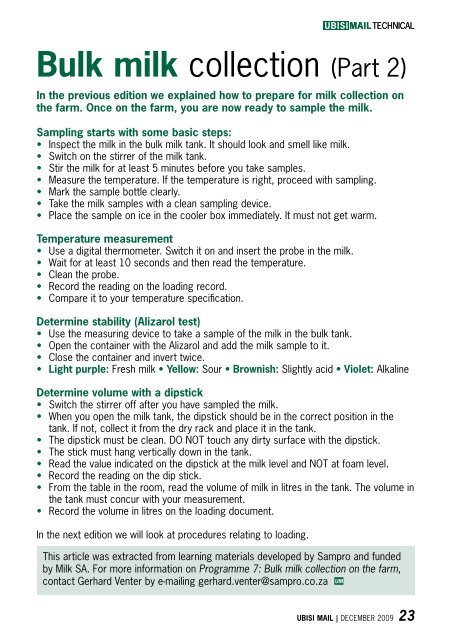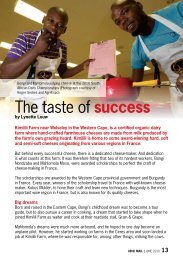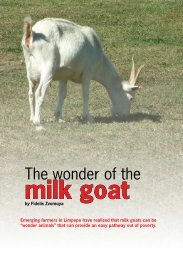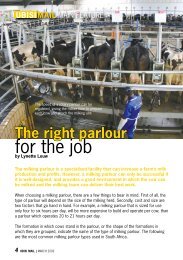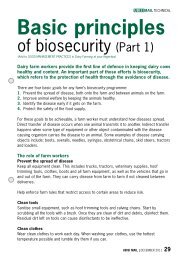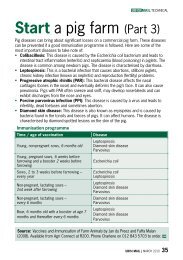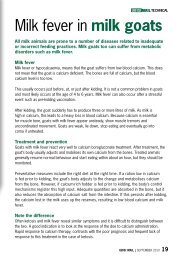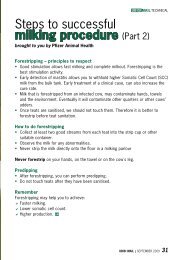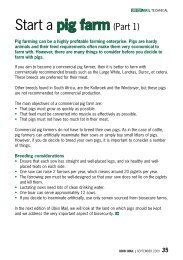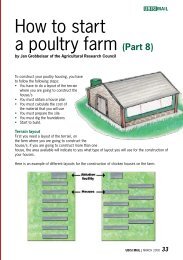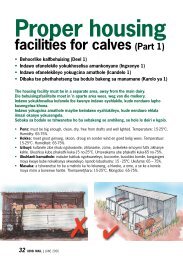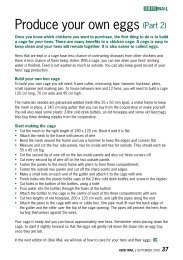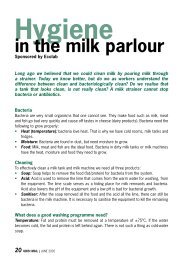Bulk milk collection (Part 2) - Ubisi Mail Magazine
Bulk milk collection (Part 2) - Ubisi Mail Magazine
Bulk milk collection (Part 2) - Ubisi Mail Magazine
- No tags were found...
You also want an ePaper? Increase the reach of your titles
YUMPU automatically turns print PDFs into web optimized ePapers that Google loves.
TECHNICAL<strong>Bulk</strong> <strong>milk</strong> <strong>collection</strong> (<strong>Part</strong> 2)In the previous edition we explained how to prepare for <strong>milk</strong> <strong>collection</strong> onthe farm. Once on the farm, you are now ready to sample the <strong>milk</strong>.Sampling starts with some basic steps:• Inspect the <strong>milk</strong> in the bulk <strong>milk</strong> tank. It should look and smell like <strong>milk</strong>.• Switch on the stirrer of the <strong>milk</strong> tank.• Stir the <strong>milk</strong> for at least 5 minutes before you take samples.• Measure the temperature. If the temperature is right, proceed with sampling.• Mark the sample bottle clearly.• Take the <strong>milk</strong> samples with a clean sampling device.• Place the sample on ice in the cooler box immediately. It must not get warm.Temperature measurement• Use a digital thermometer. Switch it on and insert the probe in the <strong>milk</strong>.• Wait for at least 10 seconds and then read the temperature.• Clean the probe.• Record the reading on the loading record.• Compare it to your temperature specification.Determine stability (Alizarol test)• Use the measuring device to take a sample of the <strong>milk</strong> in the bulk tank.• Open the container with the Alizarol and add the <strong>milk</strong> sample to it.• Close the container and invert twice.• Light purple: Fresh <strong>milk</strong> • Yellow: Sour • Brownish: Slightly acid • Violet: AlkalineDetermine volume with a dipstick• Switch the stirrer off after you have sampled the <strong>milk</strong>.• When you open the <strong>milk</strong> tank, the dipstick should be in the correct position in thetank. If not, collect it from the dry rack and place it in the tank.• The dipstick must be clean. DO NOT touch any dirty surface with the dipstick.• The stick must hang vertically down in the tank.• Read the value indicated on the dipstick at the <strong>milk</strong> level and NOT at foam level.• Record the reading on the dip stick.• From the table in the room, read the volume of <strong>milk</strong> in litres in the tank. The volume inthe tank must concur with your measurement.• Record the volume in litres on the loading document.In the next edition we will look at procedures relating to loading.This article was extracted from learning materials developed by Sampro and fundedby Milk SA. For more information on Programme 7: <strong>Bulk</strong> <strong>milk</strong> <strong>collection</strong> on the farm,contact Gerhard Venter by e-mailing gerhard.venter@sampro.co.za UMUBISI MAIL | DECEMBER 2009 23
Sampling <strong>milk</strong>1. Inspect the <strong>milk</strong> in the bulk <strong>milk</strong> tank.(Look and smell).2. Stir the <strong>milk</strong> for 5 minutes andmeasure the temperature.3.Mark the sample bottle and take the<strong>milk</strong> samples. Place it on ice in thecooler box immediately.4. Volume: read the value on the dipstick at the <strong>milk</strong> level. Record thevolume in litres on the loadingdocument.5. Load the <strong>milk</strong>.Neem melkmonsters1. Inspekteer die melk in die massatenk.(Voorkoms en reuk).2. Roer die melk vir 5 minute en neem dietemperatuur.3. Merk die botteltjie en neem diemelkmonsters. Plaas dadelik op ysin die koelhouer.4. Volume: Neem die lesing op diedoopstokkie by die melkvlak. Teken dievolume in liters op die laaidokument aan.5. Laai die melk.Nka sampole ya lebese1. Hlahloba lebitso tankeng ya lebese. (Sheba le ho nkgella lebese)2. Fuduwa lebese ka metsotso e 5 le ho lekanya thempheretjha ya lona.3. Tshwaya botlolo ya sampole le ho nka disampole tsa lebese. E behehodima leqhwa (ice) hara cooler box kapele.4. Mothamo: lekanya mothamo wa tekanyo ya lebese o sebedisa thutswana elekanyang. Ngola mothamo ka dilithara tokomaneng ya ho laela.5. Laela lebese.24 UBISI MAIL | DECEMBER 2009


